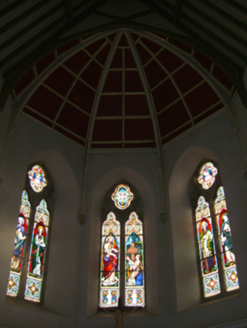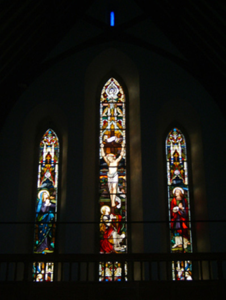Survey Data
Reg No
15700316
Rating
Regional
Categories of Special Interest
Architectural, Artistic, Historical, Social, Technical
Original Use
Church/chapel
In Use As
Church/chapel
Date
1860 - 1875
Coordinates
315712, 165817
Date Recorded
26/09/2007
Date Updated
--/--/--
Description
Detached six-bay double-height Catholic church, designed 1863; begun 1865; dedicated 1871, on a rectangular plan comprising six-bay double-height nave opening into six-bay single-storey lean-to side aisles centred on single-bay double-height apse (east) on an engaged half-octagonal plan; single-bay three-stage tower (south-west) on a square plan supporting octagonal spire. Completed, 1896. Renovated, 1970, with sanctuary reordered. Reroofed, 2007-8. Replacement pitched slate roof abutting half-octagonal slate roof (east); replacement lean-to slate roofs (side aisles), crested roll moulded clay ridge tiles, cut-granite "slated" coping to gables on gabled "Cavetto" kneelers including cut-granite "slated" coping to gable to entrance (west) front on gabled "Cavetto" kneelers with Cross finial to apex, and cast-iron rainwater goods on cut-granite "Cavetto" cornices retaining cast-iron square profile downpipes. Part repointed cut-granite banded snecked rock faced rubble stone walls on cut-granite chamfered cushion course on plinth with cut-granite buttresses to corners including cut-granite stepped buttresses to entrance (west) front having cut-granite "slated" coping. Pointed quatrefoil window openings (clerestorey), cut-granite block-and-start surrounds having chamfered reveals with hood mouldings framing fixed-pane fittings having stained glass margins centred on lattice glazing bars. Lancet window openings in bipartite arrangement (side aisles), cut-granite block-and-start surrounds having chamfered reveals with hood mouldings framing fixed-pane fittings having stained glass margins centred on leaded stained glass panels. Cusped lancet window openings in bipartite arrangement (east) with cut-granite chamfered sill course, and cut-granite block-and-start surrounds having chamfered reveals with curvilinear hood mouldings on monolithic label stops framing storm glazing over fixed-pane fittings having leaded stained glass panels. Pointed-arch door opening to entrance (west) front with cut-granite threshold, cut-granite block-and-start surround having chamfered reveals with hood moulding on monolithic label stops framing timber boarded double doors. Lancet "Trinity Window" (gable) with cut-granite crow stepped sill course, and cut-granite block-and-start surrounds having chamfered reveals with hood mouldings on monolithic label stops framing storm glazing over fixed-pane fittings having leaded stained glass panels. Interior including vestibule (west); square-headed door opening into nave with glazed timber panelled double doors having overlight; full-height interior open into roof with choir gallery (west) below stained glass memorial "Trinity Window" (----), central aisle between timber pews, pointed-arch arcades on polished Midleton marble pillars, exposed pointed-arch braced scissor truss timber roof construction on cut-granite beaded corbels with wind braced rafters to ceiling, pointed-arch chancel arch framing cut-white marble stepped dais to sanctuary (east) reordered, 1970, with quatrefoil-detailed altar below stained glass memorial windows (----), stepped daises to side altars with Gothic-style altars below stained glass windows (----), Gothic-style timber panelled confessional boxes (side aisles), paired timber stations between stained glass windows (----), and exposed strutted timber roof constructions on cut-granite beaded corbels with wind braced rafters to ceilings. Set in landscaped grounds on a corner site.
Appraisal
A church erected to a design by Pugin and Ashlin (formed 1860) of Saint Stephen's Green, Dublin (Dublin Builder 15th August 1865, 198-9), representing an important component of the mid nineteenth-century built heritage of north County Wexford with the architectural value of the composition, '[a] new Catholic Church [whose] detail is extremely severe and simple [with] no tracery being introduced except in the chancel and side chapel windows' (ibid., 198-9), confirmed by such attributes as the compact plan form, aligned along a liturgically-correct axis; the construction in a blue-green calp stone offset by silver-grey granite dressings not only demonstrating good quality workmanship, but also producing a pleasing palette; the slender profile of the coupled openings underpinning a "medieval" Gothic theme with the polygonal apse defined by cusped "East Windows"; and the pinnacled polygonal spire embellishing the tower as a prominent eye-catcher in the landscape. Having been well maintained, the elementary form and massing survive intact together with substantial quantities of the original fabric, both to the exterior and to the arcaded interior reordered (1970) in accordance with the liturgical reforms sanctioned by the Second Ecumenical Council of the Vatican (1962-5) where the Woodburn Memorial "Trinity Window" (----); contemporary joinery; a much modified high altar; the Doyle Memorial Windows (----); and stained glass donated by Colonel Richard Percival Wemyss Quin (1872-1945) of nearby Borleagh House, all highlight the artistic potential of the composition: meanwhile, an exposed timber roof construction pinpoints the engineering or technical dexterity of a church forming part of a self-contained group alongside an adjacent parochial house (see 15700317) with the resulting ecclesiastical ensemble making a pleasing visual statement in a rural village setting.



















